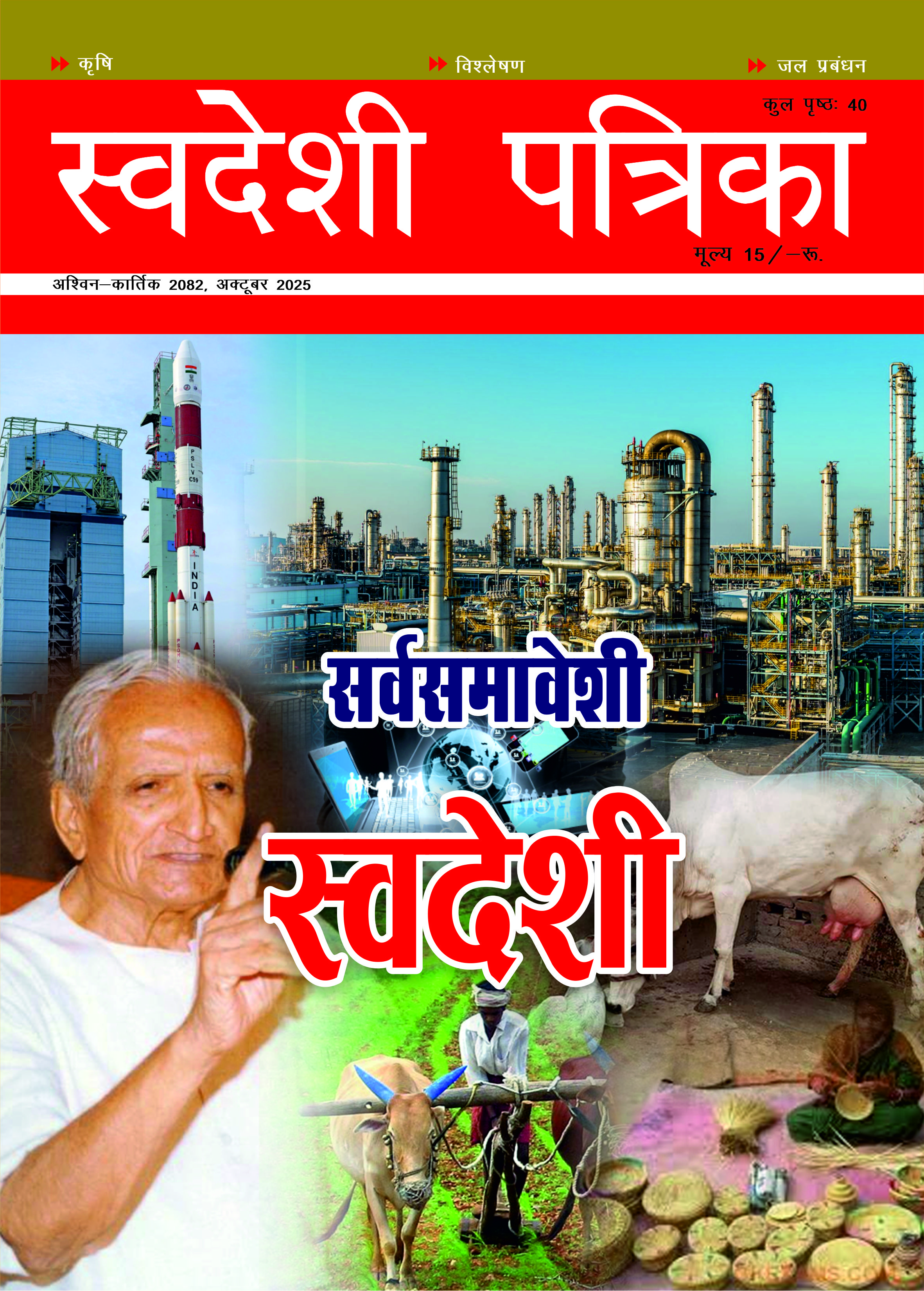
Privatisation of Nuclear Energy Sector: Budget Proposals and Implications
The Budget speech has stated that at least five Small Modular Reactors (SMR) will be indigenously developed and operationalised by 2033. — Dr. Dhanpat Ram Agarwal
The Union Budget 2025-26 has been presented in Parliament on the 1st February 2025. Normally a Budget is presumably considered to be a Financial Statement with various tax proposals for revenue generation and the Government expenditures along with certain policy statements for the overall economic growth and certain schemes for the farmers and for rural development and certain other important fiscal announcements. However in this year’s budget proposals there is a very silent mention of certain very important announcement on the Energy Security through Nuclear Energy Mission. In paragraph 61-62 of the Budget Speech, Hon’ble Finance Minister has spoken about the proposal for the Nuclear Energy Mission for Viksit Bharat. It says that development of at least 100 GW of nuclear energy by 2047 is essential for our energy transition efforts. She has proposed for necessary amendments to the Atomic Energy Act 1962 and the Civil Liability for Nuclear Damage Act 2010 for an active partnership with the private sector towards this goal. It has further elaborated and has spelt out the need for an outlay of Rs.20000 crores for setting up research & development facilities in order to carry out this mission. The Budget speech has stated that at least five Small Modular Reactors (SMR) will be indigenously developed and operationalised by 2033.
Therefore, there is a need to understand about the nuances of this mission particularly the implications for the proposed amendments in the Atomic Energy Act 1962 and the Civil Liability Nuclear damage Act 2010. There is simultaneous need to understand the implications for the proposed active participation of the private sector as to whether it would also allow FDI and foreign technology collaboration and partial or wholly allow MNCs in the Nuclear Energy generation or a limited entry for research and development of the Small Modular Reactors (SMR). What would be the total cost outlay for 100 GW for the nuclear energy and what would be the requirements for Uranium or the other alternative sources of the raw materials like Thorium for producing the nuclear energy. It would be also necessary to understand the implications of the Indo-US nuclear deal signed in the year 2007.
In order to understand the above issues, let us first understand the genesis and the objectives of the Nuclear Energy Mission. The amendments to the Atomic Energy Act and the Civil liabilities Act were the prerequisites of the India – US 123 Agreement of 2007 which were pending for a long time which our country had not been agreeing for a long time since 2007-08 after signing the Indo-US Nuclear deal as Atomic Energy was reserved for the Government and no private sector was allowed on the basic ground of national security.
It is apparently reflected and as is the evident from the recent visit of the Indian Prime Minister Shri Narendra Modi to USA and from the Joint statement issued after the Bilateral Meeting at the white house with the US President Mr. Donald Trump in Washington DC on 13th February 2025, within less than two weeks from the announcement in the Union Budget on the 1st February 2025. The gist of one of the various other issues as stated in the Joint Statement with the caption “Energy Security” is as below:
Energy security
- Re-committed to the US-India Energy Security Partnership, including in oil, gas, and civil nuclear energy.
- US support for India to join the International Energy Agency as a full member.
- To fully realize the US-India 123 Civil Nuclear Agreement by moving forward with plans to work together to build US-designed nuclear reactors in India through large scale localization and possible technology transfer.
- Unlock plans to build large US-designed reactors and enable collaboration to develop, deploy and scale up nuclear power generation with advanced small modular reactors.
Thus it is believed that the hasty announcement about the proposal for amending the Atomic Energy Act was in the background of the ensuing PM visit to France and USA immediately after the placement of the Budget. One may also argue and agree that the basic idea is to comply with the requirements of the Paris agreement for climate change and to look for long term energy security. Thus, this mission seems aligned with India’s commitment to reducing carbon emissions and meeting future energy demands, positioning nuclear energy as a pivotal component of the nation’s energy strategy and to meet net zero commitments by 2070.
The Government desires to align the above objectives with Viksit Bharat and feels that there is need for intensive research and it may require huge capital investment and technological collaboration by involving private sector which requires amendments in the present legal framework. Therefore, the Proposed Amendments are:
1. Atomic Energy Act
Current Restriction: The Atomic Energy Act of 1962 restricts nuclear power generation to government entities, specifically the Nuclear Power Corporation of India Limited (NPCIL) and Bharatiya Nabhikiya Vidyut Nigam Limited (BHAVINI).
Proposed Change: Amendments aim to permit private companies to own and operate nuclear power plants, thereby encouraging public-private partnerships (PPPs) in the nuclear sector.
2. Civil Liability for Nuclear Damage Act (CLNDA)
Current Provision: Enacted in 2010, the CLNDA imposes strict liability on nuclear plant operators and grants them the right to seek recourse from suppliers in case of accidents caused by defective equipment or services. This has deterred foreign suppliers due to potential unlimited liability.
Proposed Change: The government plans to amend the CLNDA to align with international norms, potentially limiting or removing supplier liability. This alignment is expected to address concerns of foreign nuclear suppliers and facilitate stalled projects with companies from the U.S. and France.
Impact on India’s Strategic Nuclear Partnerships
Changes in private sector participation and liability concessions in India’s nuclear energy sector will have significant implications for its strategic partnerships with key countries, particularly the United States, Russia, and France. It is likely to have major foreign influence on our nuclear research program which is highly sensitive from the National Security point of view and may also come in the way of our indigenous existing research. The relaxations and the concessions for the nuclear damages and for the civil liability as contained in the present law CLINDA may prove to be very dangerous as per our painful experience from the Bhopal Gas tragedy. India should have continued with the present proposal of insurance pool which is in practice in many countries. Russia has already agreed on this Insurance pool arrangements through its company Rosatom, our most reliable partner, constructing Kudankulam Nuclear Plant (KNPP) and planning new projects.
USA has the plan to execute and revive the six AP1000 reactors planned in Kovvada, Andhra Pradesh with Westinghouse if India softens liability rules or offers indemnity via an insurance pool. Similarly France’s EDF has been negotiating for the Jaitapur Power Plant (Maharashtra), the World’s largest nuclear power plant (6 EPR reactors, 9.6 GW capacity). EDF too has demanded liability concessions similar to what was proposed by Westinghouse of USA.
It is argued that by allowing USA, Russia and France, India can leverage these partnerships to counter China’s nuclear diplomacy, particularly I Africa and Southeast Asia.
However, India’s long term energy security and strategic autonomy depend upon reducing reliance on foreign nuclear technology and developing an independent nuclear energy ecosystem. India should rely upon its existing technology and further research. We already have expertise in Pressurised Heavy water Reactors (PHWRs) developed by Bhabha Atomic Research centre (BARC), the 700 MW Indian PHWR is the backbone of India’s civil nuclear program. The next step is to accelerate the Advanced Heavy Water Reactor (AHWR) and commercialise the prototype Fast Breeder Reactor (PFBR) under BHAVINI to establish a thorium based energy cycle reducing uranium dependence. This is important as we are not the part of nuclear supply group as we have not signed the Nuclear Proliferation Treaty (NPT) as the same is not in our national security interests. We can simultaneously encourage our domestic companies like L&T and BHEL and few others which has the potential to work in this field.
Small Modular Reactors (SMRS) and next-gen nuclear tech are a game changer forIndia’s distributed power needs, especially in remote areas, islands and industrial hubs where IITs and BARC can collaborate and make India self-reliant in Nuclear Technology. India has 25% of the World’s thorium reserves, giving it a long term strategic edge in nuclear energy which can be the primary fuel by 2047 when India become Viksit Bharat.
(National Co-Convenor, SJM)


